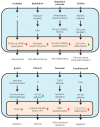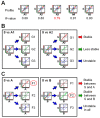DNA Microarray-Based Screening and Characterization of Traditional Chinese Medicine
- PMID: 28146102
- PMCID: PMC5374364
- DOI: 10.3390/microarrays6010004
DNA Microarray-Based Screening and Characterization of Traditional Chinese Medicine
Abstract
The application of DNA microarray assay (DMA) has entered a new era owing to recent innovations in omics technologies. This review summarizes recent applications of DMA-based gene expression profiling by focusing on the screening and characterizationof traditional Chinese medicine. First, herbs, mushrooms, and dietary plants analyzed by DMA along with their effective components and their biological/physiological effects are summarized and discussed by examining their comprehensive list and a list of representative effective chemicals. Second, the mechanisms of action of traditional Chinese medicine are summarized by examining the genes and pathways responsible for the action, the cell functions involved in the action, and the activities found by DMA (silent estrogens). Third, applications of DMA for traditional Chinese medicine are discussed by examining reported examples and new protocols for its use in quality control. Further innovations in the signaling pathway based evaluation of beneficial effects and the assessment of potential risks of traditional Chinese medicine are expected, just as are observed in other closely related fields, such as the therapeutic, environmental, nutritional, and pharmacological fields.
Keywords: DNA microarray; estrogen; food chemicals; signaling pathway; traditional Chinese medicine.
Conflict of interest statement
The author declares no conflict of interest.
Figures


Similar articles
-
The structures and biological functions of polysaccharides from traditional Chinese herbs.Prog Mol Biol Transl Sci. 2019;163:423-444. doi: 10.1016/bs.pmbts.2019.03.003. Epub 2019 Mar 25. Prog Mol Biol Transl Sci. 2019. PMID: 31030757 Free PMC article. Review.
-
Estrogenic Potentials of Traditional Chinese Medicine.Am J Chin Med. 2017;45(7):1365-1399. doi: 10.1142/S0192415X17500756. Epub 2017 Sep 25. Am J Chin Med. 2017. PMID: 28946770 Review.
-
Enhancement of Plant Productivity in the Post-Genomics Era.Curr Genomics. 2016 Aug;17(4):295-6. doi: 10.2174/138920291704160607182507. Curr Genomics. 2016. PMID: 27499678 Free PMC article.
-
[Study on relevance mining of "core drug action target" in Dictionary of Traditional Chinese Medicine Prescriptions].Zhongguo Zhong Yao Za Zhi. 2018 Oct;43(19):3919-3926. doi: 10.19540/j.cnki.cjcmm.20180710.002. Zhongguo Zhong Yao Za Zhi. 2018. PMID: 30453719 Chinese.
-
"Omics" in pharmaceutical research: overview, applications, challenges, and future perspectives.Chin J Nat Med. 2015 Jan;13(1):3-21. doi: 10.1016/S1875-5364(15)60002-4. Chin J Nat Med. 2015. PMID: 25660284 Review.
Cited by
-
Wild Mushrooms: A Hidden Treasure of Novel Bioactive Compounds.Int J Anal Chem. 2023 Sep 22;2023:6694961. doi: 10.1155/2023/6694961. eCollection 2023. Int J Anal Chem. 2023. PMID: 37781342 Free PMC article.
-
Natural Products for Drug Discovery in the 21st Century: Innovations for Novel Drug Discovery.Int J Mol Sci. 2018 May 25;19(6):1578. doi: 10.3390/ijms19061578. Int J Mol Sci. 2018. PMID: 29799486 Free PMC article. Review.
-
Estrogenic Activity of Coffee Constituents.Nutrients. 2019 Jun 21;11(6):1401. doi: 10.3390/nu11061401. Nutrients. 2019. PMID: 31234352 Free PMC article. Review.
-
Gongjin-Dan Enhances Neurite Outgrowth of Cortical Neuron by Ameliorating H2O2-Induced Oxidative Damage via Sirtuin1 Signaling Pathway.Nutrients. 2021 Nov 27;13(12):4290. doi: 10.3390/nu13124290. Nutrients. 2021. PMID: 34959841 Free PMC article.
References
-
- Liu C., Tseng A., Yang S. Chinese Herbal Medicine: Modern Applications of Traditional Formulas. CRC Press; Boca Raton, FL, USA: 2007.
-
- Luo G., Wang Y., Liang Q., Liu Q. Systems Biology for Traditional Chinese Medicine. John Wiley & Sons; Hoboken, NJ, USA: 2012.
-
- Hard to swallow. Nature. 2007;448:105–106. - PubMed
-
- Li S.-P., Wang Y.-T. Pharmacological Activity-Based Quality Control of Chinese Herbs. Nova Science Publishers; New York, NY, USA: 2008.
Publication types
LinkOut - more resources
Full Text Sources
Other Literature Sources

